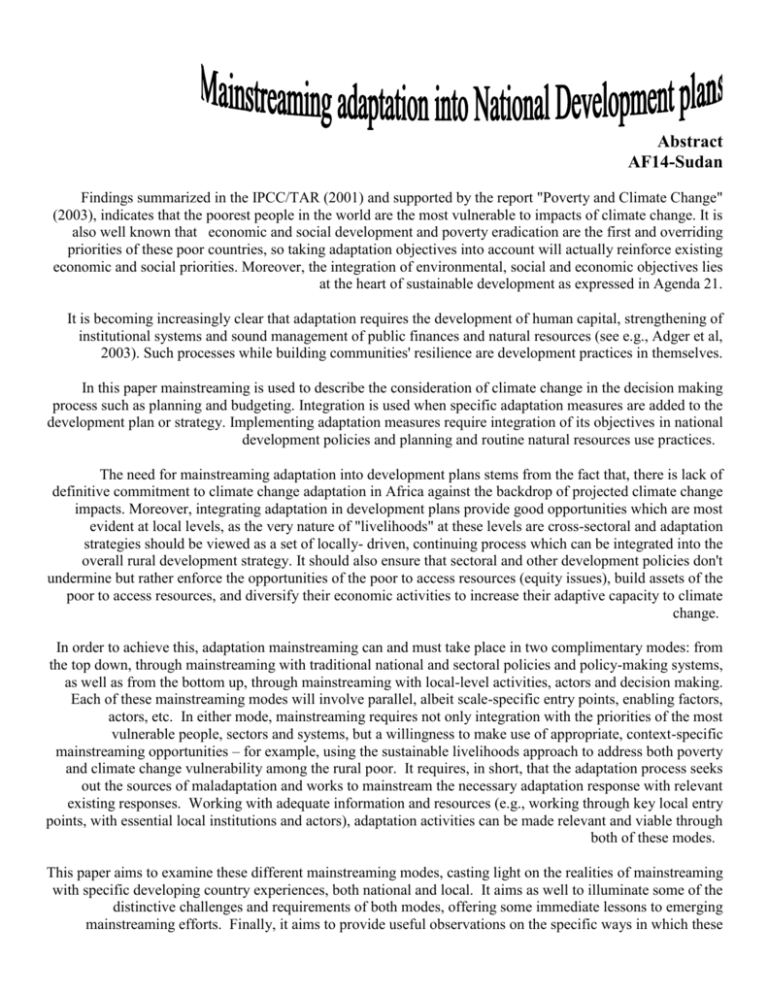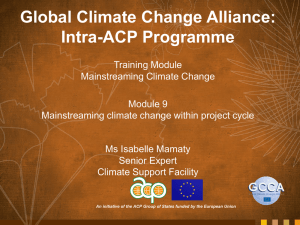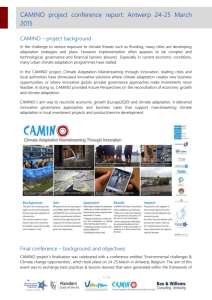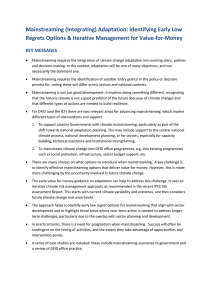Abstract
advertisement

Abstract AF14-Sudan Findings summarized in the IPCC/TAR (2001) and supported by the report "Poverty and Climate Change" (2003), indicates that the poorest people in the world are the most vulnerable to impacts of climate change. It is also well known that economic and social development and poverty eradication are the first and overriding priorities of these poor countries, so taking adaptation objectives into account will actually reinforce existing economic and social priorities. Moreover, the integration of environmental, social and economic objectives lies at the heart of sustainable development as expressed in Agenda 21. It is becoming increasingly clear that adaptation requires the development of human capital, strengthening of institutional systems and sound management of public finances and natural resources (see e.g., Adger et al, 2003). Such processes while building communities' resilience are development practices in themselves. In this paper mainstreaming is used to describe the consideration of climate change in the decision making process such as planning and budgeting. Integration is used when specific adaptation measures are added to the development plan or strategy. Implementing adaptation measures require integration of its objectives in national development policies and planning and routine natural resources use practices. The need for mainstreaming adaptation into development plans stems from the fact that, there is lack of definitive commitment to climate change adaptation in Africa against the backdrop of projected climate change impacts. Moreover, integrating adaptation in development plans provide good opportunities which are most evident at local levels, as the very nature of "livelihoods" at these levels are cross-sectoral and adaptation strategies should be viewed as a set of locally- driven, continuing process which can be integrated into the overall rural development strategy. It should also ensure that sectoral and other development policies don't undermine but rather enforce the opportunities of the poor to access resources (equity issues), build assets of the poor to access resources, and diversify their economic activities to increase their adaptive capacity to climate change. In order to achieve this, adaptation mainstreaming can and must take place in two complimentary modes: from the top down, through mainstreaming with traditional national and sectoral policies and policy-making systems, as well as from the bottom up, through mainstreaming with local-level activities, actors and decision making. Each of these mainstreaming modes will involve parallel, albeit scale-specific entry points, enabling factors, actors, etc. In either mode, mainstreaming requires not only integration with the priorities of the most vulnerable people, sectors and systems, but a willingness to make use of appropriate, context-specific mainstreaming opportunities – for example, using the sustainable livelihoods approach to address both poverty and climate change vulnerability among the rural poor. It requires, in short, that the adaptation process seeks out the sources of maladaptation and works to mainstream the necessary adaptation response with relevant existing responses. Working with adequate information and resources (e.g., working through key local entry points, with essential local institutions and actors), adaptation activities can be made relevant and viable through both of these modes. This paper aims to examine these different mainstreaming modes, casting light on the realities of mainstreaming with specific developing country experiences, both national and local. It aims as well to illuminate some of the distinctive challenges and requirements of both modes, offering some immediate lessons to emerging mainstreaming efforts. Finally, it aims to provide useful observations on the specific ways in which these mainstreaming modes can be constructed to respond most effectively to the adaptation needs of the most vulnerable people, sectors and systems. When attempting to mainstream adaptation in development plans we should emphasize the social dimension of sustainable development especially in rural poor areas where lack of prioritization and limited resources are sometimes the main impediments to actions. Policy and planning need to be reviewed to identify significant impacts on communities' adaptive mechanisms and promote win-win approaches, which support both development and local community's adaptation objectives, and at the same time provide a supportive environment for sustainable natural resource management. Adaptation framework under consideration could be a simple adaptation actions or measures at the local community level, National Adaptation Plans of Actions (NAPA) or adaptation programs and strategies at the national or regional levels. Adaptation measures could be integrated into existing planning procedures, national sustainable development policies and strategies as well as into the national action plans of international agreements (biodiversity, desertification etc.). However, to make mainstreaming possible, there is a need to first overcome the obstacles facing the process among which is limited participation by local communities in the decision-making process which lead to the development of unsupported policy and institutional frameworks. In addition to the lack of attention among scientists to identify links to sectoral policies and plans and develop mechanisms for synergies and integration.










